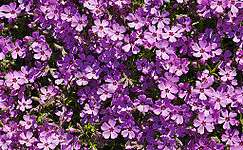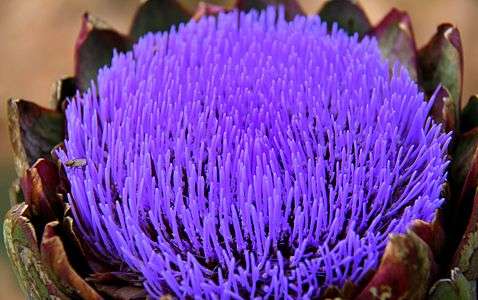Purple
| Purple | |||||||
|---|---|---|---|---|---|---|---|
| |||||||
| Hex triplet | #800080 | ||||||
| sRGBB (r, g, b) | (128, 0, 128) | ||||||
| CMYKH (c, m, y, k) | (50, 100, 0, 0) | ||||||
| HSV (h, s, v) | (300°, 100%, 50%) | ||||||
| Source | HTML | ||||||
|
B: Normalized to [0–255] (byte) H: Normalized to [0–100] (hundred) | |||||||
Purple is a color intermediate between red and blue.[1][2] It is similar to violet, but unlike violet, which is a spectral color with its own wavelength on the visible spectrum of light, purple is a composite color made by combining red and blue.[3] According to surveys In Europe and the U.S., purple is the color most often associated with royalty, magic, mystery and piety.[4] When combined with pink, it is associated with eroticism, femininity and seduction.[5]
Purple was the color worn by Roman magistrates; it became the imperial color worn by the rulers of the Byzantine Empire and the Holy Roman Empire, and later by Roman Catholic bishops. Similarly in Japan, the color is traditionally associated with the Emperor and aristocracy.[6]
Etymology and definitions
The word 'purple' comes from the Old English word purpul which derives from the Latin purpura, in turn from the Greek πορφύρα (porphura),[7] name of the Tyrian purple dye manufactured in classical antiquity from a mucus secreted by the spiny dye-murex snail.[8][9]
The first recorded use of the word 'purple' in the English language was in the year 975 AD.[10] In heraldry, the word purpure is used for purple.[11]
Varieties and uses of purple
-

Purple is the color of royalty. A ticket for the coronation of Elizabeth II (1953)
-
In Catholicism purple is a liturgical color representing piety
-
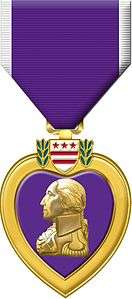
The Purple Heart is awarded to members of the United States Armed Forces who are wounded in action
-

Amethyst gemstones
-
A purple beech, also known as copper beech (Fagus sylvatica)
-

Eggplants (or Aubergines in British English)
-
Plums (Prunus domestica)
-
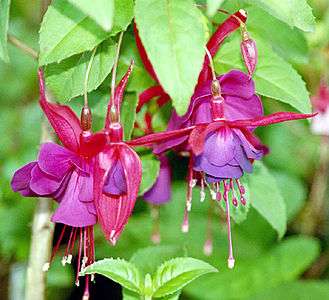
Fuchsia in the RGB color model is purple at maximum brightness. The color is named for the flower, which is named for German scientist Leonhart Fuchs (1501–1566)
-
The color magenta is very similar to fuchsia. In color printing, it is a primary color, along with cyan and yellow. It takes its name from a battle in 1859 at the city of Magenta, Italy
-
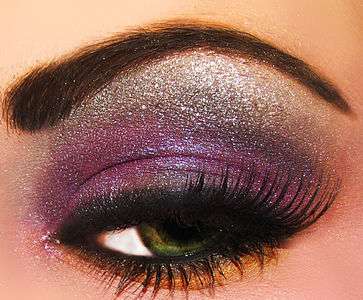
Purple eye shadow is intended to create the illusion of depth and to attract attention to the eyes
- ^ Eva Heller, Psychologie de la couleur: effets et symboliques.
Purple vs. violet
| Violet | |
|---|---|
| Hex triplet | #8F00FF |
| sRGBB (r, g, b) | (143, 0, 255) |
| CMYKH (c, m, y, k) | (44, 100, 0, 0) |
| HSV (h, s, v) | (274°, 100%, 100[12]%) |
| Source | HTML Color Chart @274 |
|
B: Normalized to [0–255] (byte) H: Normalized to [0–100] (hundred) | |
In the traditional color wheel used by painters, violet and purple are both placed between red and blue. Purple occupies the space closer to red, between crimson and violet.[13] Violet is closer to blue, and is usually less saturated than purple.
While the two colors look similar, from the point of view of optics there are important differences. Violet is a spectral color – it occupies its own place at the end of the spectrum of light first identified by Newton in 1672, and it has its own wavelength (approximately 380–420 nm) – whereas purple is a combination of two spectral colors, red and blue. There is no such thing as the "wavelength of purple light"; it only exists as a combination.[14][15] See purple boundary.
Monochromatic violet light cannot be produced by the red-green-blue (RGB) color system, the method used to create colors on a television screen or computer display (a fact that is, indeed, true of any monochromatic color of the spectrum besides the shades of red, green, and blue chosen for the primaries). However, the system is capable of approximating it due to the fact that the L-cone (red cone) in the eye is uniquely sensitive to two different discontinuous regions in the visible spectrum – its primary region being the long wavelength light of the yellow-red region of the spectrum, and a secondary smaller region overlapping with the S-cone (blue cone) in the shortest wavelength, violet part.[16] This means that when violet light strikes the eye, the S-cone should be stimulated strongly, and the L-cone stimulated weakly along with it. By lighting the red primary of the display weakly along with the blue primary, a relatively similar pattern of sensitization can be achieved, creating an illusion, the sensation of extremely short wavelength light using what is in fact mixed light of two longer wavelengths. The resulting color has the same hue as pure violet; however, it has a lower saturation.
One curious psychophysical difference between purple and violet is their appearance with an increase in luminance (apparent brightness). Violet, as it brightens, looks more and more blue. The same effect does not happen with purple. This is the result of what is known as the Bezold–Brücke shift.
While the scientific definitions of violet and purple are clear, the cultural definitions are more varied. The color known in antiquity as Tyrian purple ranged from crimson to a deep bluish-purple, depending upon how it was made. In France, purple is defined as "a dark red, inclined toward violet."[17] The color called purple by the French, pourpre, contains more red and half the amount of blue of the color called purple in the United States and the U.K. In German, this color is sometimes called Purpurrot ("purple-red") to avoid confusion.[18]
-

The color violet
-

The color purple
-

In the traditional Boutet color circle (1708), purple is shown between crimson and violet.
-

The French call the color on this shield "pourpre" (purple). French and German purple contains more red and less blue than American or British purple.
In art, history and fashion
In prehistory and the ancient world: Tyrian purple

Purple first appeared in prehistoric art during the Neolithic era. The artists of Pech Merle cave and other Neolithic sites in France used sticks of manganese and hematite powder to draw and paint animals and the outlines of their own hands on the walls of their caves. These works have been dated to between 16,000 and 25,000 BC.[19]
As early as the 15th century BC the citizens of Sidon and Tyre, two cities on the coast of Ancient Phoenicia, (present day Lebanon), were producing purple dye from a sea snail called the spiny dye-murex.[20] Clothing colored with the Tyrian dye was mentioned in both the Iliad of Homer and the Aeneid of Virgil.[20] The deep, rich purple dye made from this snail became known as Tyrian purple.[21]
The process of making the dye was long, difficult and expensive. Thousands of the tiny snails had to be found, their shells cracked, the snail removed. Mountains of empty shells have been found at the ancient sites of Sidon and Tyre. The snails were left to soak, then a tiny gland was removed and the juice extracted and put in a basin, which was placed in the sunlight. There a remarkable transformation took place. In the sunlight the juice turned white, then yellow-green, then green, then violet, then a red which turned darker and darker. The process had to be stopped at exactly the right time to obtain the desired color, which could range from a bright crimson to a dark purple, the color of dried blood. Then either wool, linen or silk would be dyed. The exact hue varied between crimson and violet, but it was always rich, bright and lasting.[22]
Tyrian purple became the color of kings, nobles, priests and magistrates all around the Mediterranean. It was mentioned in the Old Testament; In the Book of Exodus, God instructs Moses to have the Israelites bring him an offering including cloth "of blue, and purple, and scarlet.",[23] to be used in the curtains of the Tabernacle and the garments of priests. The term used for purple in the 4th-century Latin Vulgate version of the Bible passage is purpura or Tyrian purple.[24] In the Iliad of Homer, the belt of Ajax is purple, and the tails of the horses of Trojan warriors are dipped in purple. In the Odyssey, the blankets on the wedding bed of Odysseus are purple. In the poems of Sappho (6th century BC) she celebrates the skill of the dyers of the Greek kingdom of Lydia who made purple footwear, and in the play of Aeschylus (525–456 BC), Queen Clytemnestra welcomes back her husband Agamemnon by decorating the palace with purple carpets. In 950 BC, King Solomon was reported to have brought artisans from Tyre to provide purple fabrics to decorate the Temple of Jerusalem.[25]
Alexander the Great (when giving imperial audiences as the basileus of the Macedonian Empire), the basileus of the Seleucid Empire, and the kings of Ptolemaic Egypt all wore Tyrian purple.
The Roman custom of wearing purple togas may have come from the Etruscans; an Etruscan tomb painting from the 4th century BC shows a nobleman wearing a deep purple and embroidered toga.
In Ancient Rome, the Toga praetexta was an ordinary white toga with a broad purple stripe on its border. It was worn by freeborn Roman boys who had not yet come of age,[26] curule magistrates,[27][28] certain categories of priests,[29] and a few other categories of citizens.
The Toga picta was solid purple, embroidered with gold. During the Roman Republic, it was worn by generals in their triumphs, and by the Praetor Urbanus when he rode in the chariot of the gods into the circus at the Ludi Apollinares.[30] During the Empire, the toga picta was worn by magistrates giving public gladiatorial games, and by the consuls, as well as by the emperor on special occasions.
During the Roman Republic, when a triumph was held, the general being honored wore an entirely purple toga bordered in gold, and Roman Senators wore a toga with a purple stripe. However, during the Roman Empire, purple was more and more associated exclusively with the emperors and their officers.[31] The Emperor Caligula had the King of Mauritania murdered for wearing a purple mantle better than his own. Nero made it punishable by death for anyone else to wear the color.
Jesus, in the hours leading up to his crucifixion, was dressed in purple (πορφύρα: porphura) by the Roman garrison to mock his claim to be 'King of the Jews'.[32]
The actual color of Tyrian purple seems to have varied from a reddish to a bluish purple. According to the Roman writer Vitruvius, (1st century BC), the murex coming from northern waters, probably murex brandaris, produced a more bluish color than those of the south, probably murex trunculus. The most valued shades were said to be those closer to the color of dried blood, as seen in the mosaics of the robes of the Emperor Justinian in Ravenna. The chemical composition of the dye from the murex is close to that of the dye from indigo, and indigo was sometimes used to make a counterfeit Tyrian purple, a crime which was severely punished. What seems to have mattered about Tyrian purple was not its color, but its luster, richness, its resistance to weather and light, and its high price.[33]
In modern times, Tyrian purple has been recreated, at great expense. When the German chemist, Paul Friedander, tried to recreate Tyrian purple in 2008, he needed twelve thousand mollusks to create 1.4 ounces of dye, enough to color a handkerchief. In the year 2000, a gram of Tyrian purple made from ten thousand mollusks according to the original formula, cost two thousand euro.[34][35]
-
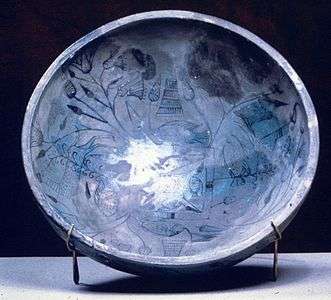
An Egyptian bowl colored with Egyptian blue, with motifs painted in dark manganese purple. (between 1550 and 1450 BC)
-
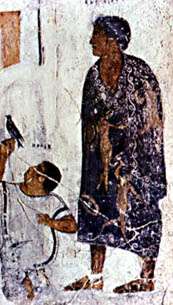
Painting of a man wearing an all-purple toga picta, from an Etruscan tomb (about 350 BC).
-

Roman men wearing togae praetextae with reddish-purple stripes during a religious procession (1st century BC).
-

Tyrian purple was made from a sea snail called murex
-
Dye bath of Tyrian purple
-

Cloth dyed with Tyrian purple. The color could vary from crimson to deep purple, depending upon the type of murex sea-snail and how it was made.
Purple in the Byzantine Empire and Carolingian Europe
Through the early Christian era, the rulers of the Byzantine Empire continued the use of purple as the imperial color, for diplomatic gifts, and even for imperial documents and the pages of the Bible. Gospel manuscripts were written in gold lettering on parchment that was colored Tyrian purple.[36] Empresses gave birth in the Purple Chamber, and the emperors born there were known as "born to the purple," to separate them from emperors who won or seized the title through political intrigue or military force. Bishops of the Byzantine church wore white robes with stripes of purple, while government officials wore squares of purple fabric to show their rank.
In western Europe, the Emperor Charlemagne was crowned in 800 wearing a mantle of Tyrian purple, and was buried in 814 in a shroud of the same color, which still exists (see below). However, after the fall of Constantinople to the Ottoman Turks in 1453, the color lost its imperial status. The great dye works of Constantinople were destroyed, and gradually scarlet, made with dye from the cochineal insect, became the royal color in Europe.[37]
-

The Empress Theodora, the wife of the Emperor Justinian, dressed in Tyrian purple. (6th century).
-

11th-century Byzantine robe, dyed Tyrian purple with murex dye. Creatures are griffins
-

A medieval depiction of the coronation of the Emperor Charlemagne in 800. The bishops and cardinals wear purple, and the Pope wears white.
-

A fragment of the shroud in which the Emperor Charlemagne was buried in 814. It was made of gold and Tyrian purple from Constantinople.
The Middle Ages and Renaissance
In 1464, Pope Paul II decreed that cardinals should no longer wear Tyrian purple, and instead wear scarlet, from kermes and alum,[38] since the dye from Byzantium was no longer available. Bishops and archbishops, of a lower status than cardinals, were assigned the color purple, but not the rich Tyrian purple. They wore cloth dyed first with the less expensive indigo blue, then overlaid with red made from kermes dye.[39][40]
While purple was worn less frequently by Medieval and Renaissance kings and princes, it was worn by the professors of many of Europe's new universities. Their robes were modeled after those of the clergy, and they often wore square violet or purple caps and robes, or black robes with purple trim. Purple robes were particularly worn by students of divinity.
Purple and violet also played an important part in the religious paintings of the Renaissance. Angels and the Virgin Mary were often portrayed wearing purple or violet robes.
-

A 12th-century painting of Saint Peter consecrating Hermagoras, wearing purple, as a bishop.
-

Madonna and child by Giotto (1266–1320)
-
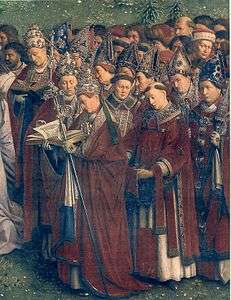
In the Ghent Altarpiece (1422) by Jan van Eyck, the popes and bishops are wearing purple robes.
-
.jpg)
A purple-clad angel from the Resurrection of Christ by Raphael (1483–1520)
18th and 19th centuries
In the 18th century, purple was still worn on occasion by Catherine the Great and other rulers, by bishops and, in lighter shades, by members of the aristocracy, but rarely by ordinary people, because of its high cost. But in the 19th century, that changed.
In 1856, an eighteen-year-old British chemistry student named William Henry Perkin was trying to make a synthetic quinine. His experiments produced instead the first synthetic aniline dye, a purple shade called mauveine, shortened simply to mauve. It took its name from the mallow flower, which is the same color. The new color quickly became fashionable, particularly after Queen Victoria wore a silk gown dyed with mauveine to the Royal Exhibition of 1862. Prior to Perkin's discovery, mauve was a color which only the aristocracy and rich could afford to wear. Perkin developed an industrial process, built a factory, and produced the dye by the ton, so almost anyone could wear mauve. It was the first of a series of modern industrial dyes which completely transformed both the chemical industry and fashion.[41]
Purple was popular with the pre-Raphaelite painters in Britain, including Arthur Hughes, who loved bright colors and romantic scenes.
-
_2.jpg)
Portrait of Empress Catherine the Great of Russia, by Fyodor Rokotov. (State Hermitage Museum).
-

In England, pre-Raphaelite painters like Arthur Hughes were particularly enchanted by purple and violet. This is April Love (1856).
-

Portrait of Félix Pissarro (1881), by Camille Pissarro
-
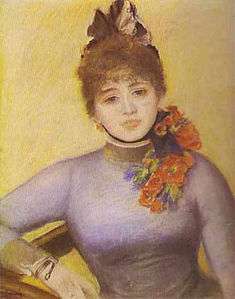
Portrait of Caroline Remy de Guebhard, by Pierre-Auguste Renoir (1841–1919).
20th and 21st centuries
At the turn of the century, purple was a favorite color of the Austrian painter Gustav Klimt, who flooded his pictures with sensual purples and violets.
In the 20th century, purple retained its historic connection with royalty; George VI (1896–1952), wore purple in his official portrait, and it was prominent in every feature of the coronation of Elizabeth II in 1953, from the invitations to the stage design inside Westminster Abbey. But at the same time, it was becoming associated with social change; with the Women's Suffrage movement for the right to vote for women in the early decades of the century, with Feminism in the 1970s, and with the psychedelic drug culture of the 1960s.
In the early 20th century, purple, green, and white were the colors of the Women's Suffrage movement, which fought to win the right to vote for women, finally succeeding with the 19th Amendment to the U.S. Constitution in 1920. Later, in the 1970s, in a tribute to the Suffragettes, it became the color of the women's liberation movement.[42]
In the concentration camps of Nazi Germany, prisoners who were members of non-conformist religious groups, such as the Jehovah's Witnesses, were required to wear a purple triangle.[43]
During the 1960s and early 1970s, it was also associated with counterculture, psychedelics, and musicians like Jimi Hendrix with his 1967 song "Purple Haze", or the English rock band of Deep Purple which formed in 1968. Later, in the 1980s, it was featured in the song and album Purple Rain (1984) by the American musician Prince.
The Purple Rain Protest was a protest against apartheid that took place in Cape Town, South Africa on 2 September 1989, in which a police water cannon with purple dye sprayed thousands of demonstrators. This led to the slogan The Purple Shall Govern.
The violet or purple necktie became very popular at the end of the first decade of the 21st century, particularly among political and business leaders. It combined the assertiveness and confidence of a red necktie with the sense of peace and cooperation of a blue necktie, and it went well with the blue business suit worn by most national and corporate leaders.[44]
-
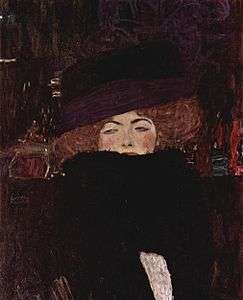
Gustav Klimt portrait of woman with a purple hat (1912).
-

George VI (1895–1952) wore purple in his official portrait.
-

The Coronation portrait of Elizabeth II and The Duke of Edinburgh (1953) has three different shades of purple in the train, curtains and crown.
-

Program from a Women's Suffrage march (1913).
-

A pennant from the Women's Suffrage movement in the state of Indiana.
-

Symbol of the Feminist movement in the United States (1970s). The purple color was chosen as a tribute to the Suffragette movement a half-century earlier.
In science and nature
The optics of purple
Purple, unlike violet, is not one of the colors of the visible spectrum. It was not one of the colors of the rainbow identified by Isaac Newton, and it does not have its own wavelength of light. For this reason, it is called a non-spectral color. It exists in culture and art, but not, in the same way that violet does, in optics. It is simply a combination, in various proportions, of two primary colors, red and blue.
In color theory, a "purple" is defined as any non-spectral color between violet and red (excluding violet and red themselves).[14] The spectral colors violet and indigo are not purples according to color theory, but they are purples according to common English usage since they are between red and blue.
In the traditional color wheel long used by painters, purple is usually placed between crimson and violet.[45] In a slightly different variation, on the color wheel, it is placed between magenta and violet. This shade is sometimes called electric purple (See Shades of purple).[46]
In the RGB color model, named for the colors red, green, and blue, used to create all the colors on a computer screen or television, the range of purples is created by mixing red and blue light of different intensities on a black screen. The standard HTML color purple is created by red and blue light of equal intensity, at a brightness that is halfway between full power and darkness.
In color printing, purple is sometimes represented by the color magenta, or sometimes by mixing magenta with red or blue. It can also be created by mixing just red and blue alone, but in that case the purple is less bright, with lower saturation or intensity. A less bright purple can also be created with light or paint by adding a certain quantity of the third primary color (green for light or yellow for pigment).
On a chromaticity diagram, the straight line connecting the extreme spectral colors (red and violet) is known as the line of purples (or 'purple boundary'); it represents one limit of human color perception. The color magenta used in the CMYK printing process is near the center of the line of purples, but most people associate the term "purple" with a somewhat bluer tone, such as is displayed by the color "electric purple" (a color also directly on the line of purples), shown below. Some common confusion exists concerning the color names "purple" and "violet". Purple is a mixture of red and blue light, whereas violet is a spectral color.
On the CIE xy chromaticity diagram, violet is on the curved edge in the lower left, while purples are on the straight line connecting the extreme colors red and violet; this line is known as the line of purples, or the purple line.[47][48]
-

On a computer or television screen, purple colors are created by mixing red and blue light. This is called the RGB color model.
Pigments
- Hematite and manganese are the oldest pigments used for the color purple. They were used by Neolithic artists in the form of sticks, like charcoal, or ground and powdered and mixed with fat, and used as a paint. Hematite is a reddish iron oxide which, when ground coarsely, makes a purple pigment. Manganese was also used in Roman times to color glass purple.[49]
- Han purple was the first synthetic purple pigment, invented in China in about 700 BC. It was used in wall paintings and pottery and other applications. In color, it was very close to indigo, which had a similar chemical structure. Han purple was very unstable, and sometimes was the result of the chemical breakdown of Han blue.
During the Middle Ages, artists usually made purple by combining red and blue pigments; most often blue azurite or lapis-lazuili with red ochre, cinnabar, or minium. They also combined lake colors made by mixing dye with powder; using woad or indigo dye for the blue, and dye made from cochineal for the red.[50]
- Cobalt violet was the first modern synthetic color in the purple family, manufactured in 1859. It was found, along with cobalt blue, in the palette of Claude Monet, Paul Signac, and Georges Seurat. It was stable, but had low tinting power and was expensive, so quickly went out of use.[51]
- Manganese violet was a stronger color than cobalt violet, and replaced it on the market.
- Quinacridone violet, one of a modern synthetic organic family of colors, was discovered in 1896 but not marketed until 1955. It is sold today under a number of brand names.
-

Manganese pigments were used in the neolithic paintings in the Lascaux cave, France.
-

A sample of purpurite, or manganese phosphate, from the Packrat Mine in Southern California.
-

A swatch of cobalt violet, popular among the French impressionists.
-

Manganese violet is a synthetic pigment invented in the mid-19th century.
-
Quinacridone violet, a synthetic organic pigment sold under many different names.
Dyes
The most famous purple dye in the ancient world was Tyrian purple, made from a type of sea snail called the murex, found around the Mediterranean. (See history section above).
In western Polynesia, residents of the islands made a purple dye similar to Tyrian purple from the sea urchin. In Central America, the inhabitants made a dye from a different sea snail, the purpura, found on the coasts of Costa Rica and Nicaragua. The Mayans used this color to dye fabric for religious ceremonies, while the Aztecs used it for paintings of ideograms, where it symbolized royalty.[50]
In the Middle Ages, those who dyed blue fabric and red fabric were members of different guilds, and were forbidden to dye any other colors than those of their own guild. Most purple fabric was made by the dyers who worked with red, and who used dye from madder or cochineal, so Medieval violet colors were inclined toward red.
Orcein, or purple moss, was another common purple dye. It was known to the ancient Greeks and Hebrews, and was made from a Mediterranean lichen called archil or dyer's moss (Roccella tinctoria), combined with an ammoniac, usually urine. Orcein began to achieve popularity again in the 19th century, when violet and purple became the color of demi-mourning, worn after a widow or widower had worn black for a certain time, before he or she returned to wearing ordinary colors.[52]
From the Middle Ages onward, purple and violet dyes for the clothing of common people were often made from the blackberry or other red fruit of the genus rubus, or from the mulberry. All of these dyes were more reddish than bluish, and faded easily with washing and exposure to sunlight.
A popular new dye which arrived in Europe from the New World during the Renaissance was made from the wood of the logwood tree (Haematoxylum campechianum), which grew in Spanish Mexico. Depending on the different minerals added to the dye, it produced a blue, red, black or, with the addition of alum, a purple color, It made a good color, but, like earlier dyes, it did not resist sunlight or washing.
In the 18th century, chemists in England, France and Germany began to create the first synthetic dyes. Two synthetic purple dyes were invented at about the same time. Cudbear is a dye extracted from orchil lichens that can be used to dye wool and silk, without the use of mordant. Cudbear was developed by Dr Cuthbert Gordon of Scotland: production began in 1758, The lichen is first boiled in a solution of ammonium carbonate. The mixture is then cooled and ammonia is added and the mixture is kept damp for 3–4 weeks. Then the lichen is dried and ground to powder. The manufacture details were carefully protected, with a ten-feet high wall being built around the manufacturing facility, and staff consisting of Highlanders sworn to secrecy.
French purple was developed in France at about the same time. The lichen is extracted by urine or ammonia. Then the extract is acidified, the dissolved dye precipitates and is washed. Then it is dissolved in ammonia again, the solution is heated in air until it becomes purple, then it is precipitated with calcium chloride; the resulting dye was more solid and stable than other purples.
Cobalt violet is a synthetic pigment that was invented in the second half of the 19th century, and is made by a similar process as cobalt blue, cerulean blue and cobalt green. It is the violet pigment most commonly used today by artists.
Mauveine, also known as aniline purple and Perkin's mauve, was the first synthetic organic chemical dye,[53][54] discovered serendipitously in 1856. Its chemical name is 3-amino-2,±9-dimethyl-5-phenyl-7-(p-tolylamino)phenazinium acetate.
Fuchsine was another synthetic dye made shortly after mauveine. It produced a brilliant fuchsia color.
In the 1950s, a new family of purple and violet synthetic organic pigments called quinacridone came onto the market. It had originally been discovered in 1896, but were not synthetized until 1936, and not manufactured until the 1950s. The colors in the group range from deep red to bluish purple in color, and have the molecular formula C20H12N2O2. They have strong resistance to sunlight and washing, and are widely used today in oil paints, water colors, and acrylics, as well as in automobile coatings and other industrial coatings.
-

Blackberries were sometimes used to make purple dye in the Middle Ages.
-

This lichen, growing on a tree in Scotland, was used in the 18th century to make a common purple dye called Cudbear.
-

A sample of silk dyed with the original mauveine dye.
-

A sample of fuchsine dye
Animals
-
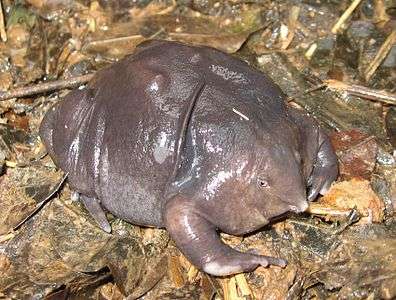
The purple frog is a species of amphibian found in India.
-

Pseudanthias pascalus or purple queenfish.
-
The purple sea urchin from Mexico.
-

A purple heron in flight (South Africa).
-
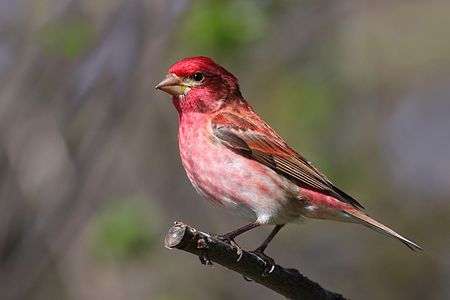
A purple finch (North America).
-

The Lorius domicella, or purple-naped lory, from Indonesia.
-

The imperial amazon parrot is featured on the national flag of Dominica, making it the only national flag in the world with a violet or purple color.
-
_male.jpg)
The purple honeycreeper from South America does not appear to be purple at all. How it received its name is a mystery.
Why grapes, eggplants and pansies are purple
Grapes, eggplants, pansies and other fruits, vegetables and flowers are purple because they contain natural pigments called anthocyanins. These pigments are found in the leaves, roots, stems, vegetables, fruits and flowers of all plants. They aid photosynthesis by blocking harmful wavelengths of light that would damage the leaves. In flowers, the purple anthocyanins help attract insects who pollinate the flowers. Not all anthocyanins are purple; they vary in color from red to purple to blue, green, or yellow, depending upon the level of their pH.
-
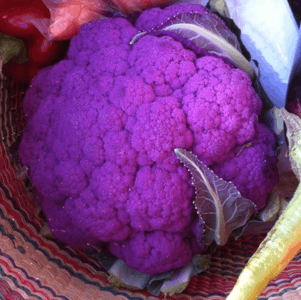
The purple colors of this cauliflower, grapes, fruits, vegetables and flowers comes from natural pigments called anthocyanins.
-
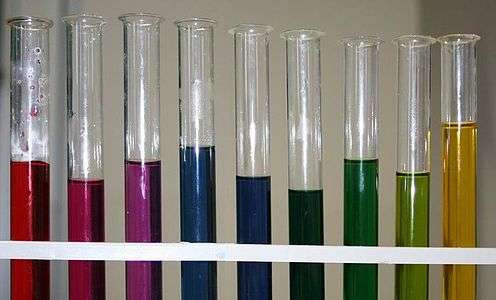
Anthocyanins range in color from red to purple to green, blue and yellow, depending upon the level of their pH.
-
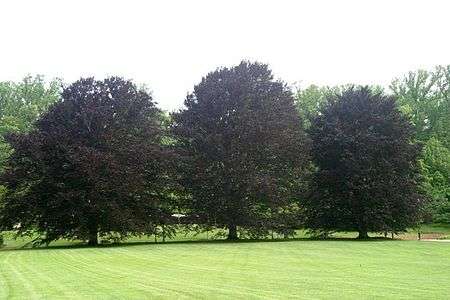
Anthocyanins also account for the purple color in these copper beech trees, and in purple autumn leaves.
-

Anthocyanins produce the purple color in blood oranges.
Plants and flowers
- Purple needlegrass is the state grass of California.
-
.jpg)
Eggplant is popular in cuisines all around the world. These are Indian eggplants.
-

Iris germanica flowers
-

Syringa vulgaris, or lilac blossoms
-
.jpg)
Medicago sativa, known as alfalfa in the U.S. and lucerne in the U.K.
-
The Aster alpinus, or alpine aster, is native to the European mountains, including the Alps, while a subspecies is found in Canada and the United States.
-

Lavender flowers.
-

A purple rose.
Microbiology
- Purple bacteria are proteobacteria that are phototrophic, that is, capable of producing energy through photosynthesis.[55]
- In April 2007 it was suggested that early archaea may have used retinal, a purple pigment, instead of chlorophyll, to extract energy from the sun. If so, large areas of the ocean and shoreline would have been colored purple; this is called the Purple Earth hypothesis.[56]
Astronomy
- One of the stars in the Pleiades, called Pleione, is sometimes called Purple Pleione because, being a fast spinning star, it has a purple hue caused by its blue-white color being obscured by a spinning ring of electrically excited red hydrogen gas.[57]
- The Purple Forbidden enclosure is a name used in traditional Chinese astronomy for those Chinese constellations that surround the North Celestial Pole.
Geography
- Purple Mountain in China is located on the eastern side of Nanjing, Jiangsu Province, People’s Republic of China. Its peaks are often found enveloped in purple clouds at dawn and dusk, hence comes its name "Purple Mountain". The Purple Mountain Observatory is located there.
- Purple Mountain in County Kerry, Ireland, takes its name from the color of the shivered slate on its summit.
- Purple Mountain in Wyoming (el. 8,392 feet (2,558 m) is a mountain peak in the southern section of the Gallatin Range in Yellowstone National Park.
- Purple Mountain, Alaska
- Purple Mountain, Oregon
- Purple Mountain, Washington
- Purple Peak, Colorado
-

Purple Mountain near Killarney, Ireland.
-
Purple Mountain in China.
Why distant mountains look blue or purple
The greater the distance from the eye to mountains, the lighter and more blue they appear. This effect, long recognized by Leonardo da Vinci and other painters, is called aerial perspective or atmospheric perspective. The more distant the mountains are, the less contrast the eye sees between the mountains and the sky.
The bluish color is caused by an optical effect called Rayleigh scattering. The sunlit sky is blue because air scatters short-wavelength light more than longer wavelengths. Since blue light is at the short wavelength end of the visible spectrum, it is more strongly scattered in the atmosphere than long wavelength red light. The result is that the human eye perceives blue when looking toward parts of the sky other than the sun.[58]
At sunrise and sunset, the light is passing through the atmosphere at a lower angle, and traveling a greater distance through a larger volume of air. Much of the green and blue is scattered away, and more red light comes to the eye, creating the colors of the sunrise and sunset and making the mountains look purple.
-
The more distant mountains are, the lighter and more blue they are. This is called atmospheric perspective or aerial perspective.
-

Sunset at Auke Bay, Alaska. Thanks to Rayleigh scattering, the mountains appear purple.
Associations and symbolism
Royalty
- In Europe, since the time of the Tyrian purple worn by Roman emperors, purple has been the color most associated with royalty. It is still used by the British Royal Family and other royalty in Europe as a ceremonial color on special occasions.[59]
-

A purple postage stamp honored Elizabeth II (1958)
-
.jpg)
The Queen of Denmark (2010).
Piety, faith, penitence, theology
In the west, purple or violet is the color most associated with piety and faith.[59] In the year 1464, shortly after the fall of Constantinople, which stopped the supply of Tyrian purple to Europe, Pope Paul II changed the color worn by cardinals from purple to red, dyed with expensive cochineal. Bishops were given the purple color made then from a less-expensive mixture of indigo and cochineal.
In the Roman Catholic liturgy, purple symbolizes penitence; priests wear a purple garment when they hear confession. Purple is also worn by priests during Lent. Since the Vatican II Council (1962–65), priests may wear purple rather than black when officiating at funerals – it was decided that black, as the color of mourning, should not be a formal part of a religious service. Purple robes are also worn as part of the academic dress worn at graduation and university ceremonies by students of theology.
Purple is also often worn by senior pastors of Protestant churches and by bishops of the Anglican Communion.
-

In the Roman Catholic church, cardinals wear red and bishops wear purple
-

Katharine Jefferts Schori, Presiding Bishop of the Episcopal Church of the United States.
The color purple is also associated with royalty in the Christian aspect.
Vanity, extravagance, individualism
In Europe and America, purple is the color most associated with vanity, extravagance, and individualism. Among the seven major sins, it represents vanity. It is a color which is used to attract attention.[60]
The artificial , materialism and beauty
Purple is the color most often associated with the artificial and the unconventional. It is the major color that occurs the least frequently in nature, and was the first color to be synthesized.[61]
Ambiguity and ambivalence
Purple is the color most associated with ambiguity. Like other colors made by combining two primary colors, it is seen as uncertain and equivocal.[62]
Mourning
In Britain, purple is sometimes associated with mourning. In Victorian times, close relatives wore black for the first year following a death ("deep mourning") , and then replaced it with purple or dark green trimmed with black. This is rarely practised today.[63]
In culture and society
Asian culture
- In China, purple represents spiritual awareness, physical and mental healing, strength and abundance. A red purple symbolizes luck and fame. The Chinese word for purple, zi, is connected with the North Star, Polaris, or zi Wei in Chinese.
- In Chinese astrology the North Star was the home of the Celestial Emperor, the ruler of the heavens (As noted above, the area around the North Star is called the Purple Forbidden Enclosure in Chinese astronomy.). For that reason the forbidden city in Beijing was also known as the purple forbidden city (zi Jin cheng).
- In Chinese painting, the color purple represents the harmony of the universe because it is a combination of red and blue (yang and yin respectively).[64]
- In Japan, purple is the color of privilege and wealth, the color associated with the Japanese aristocracy. The word for purple is murasaki, which is also the name of the purple gromwell flower
- Purple was a popular color introduced into Japanese dress during the Heian Period (794–1185). The dye was made from the root of the alkanet plant (Anchusa officinalis), also known as murasaki in Japanese. At about the same time, Japanese painters began to use a pigment made from the same plant.[65]
- In Thailand, widows in mourning wear the color purple. Purple is also associated with Saturday on the Thai solar calendar.
-

Han purple and Han blue were synthetic colors made by artisans in China during the Han dynasty (206 BC to 220 AD) or even earlier.
-

A Japanese woman in the kimono style popular in the Heian Period (794–1185)
-

Emperor Komyo of Japan. (1322–1380). Purple was the color of the aristocracy in Japan and China.
Engineering
The color purple plays a significant role in the traditions of engineering schools across Canada. This fascination with purple is commonly attributed to the story of the sinking of the Titanic, in which the purple-clad Marine Engineers remained on board to delay the ship's sinking.[66] Purple is also the colour of the Engineering Corp in the British Military. It is common for engineers across schools in Canada to dye themselves (and their leather jackets, in the case of Queen's University engineers) purple using the medical dye Gentian Violet, especially during events such as Frosh Week.
Idioms and expressions
- Purple prose refers to pretentious or overly embellished writing. For example, a paragraph containing an excessive number of long and unusual words is called a purple passage.
- Born to the purple means someone who is born into a life of wealth and privilege. It originally was used to describe the rulers of the Byzantine Empire. The Empresses gave birth in a purple chamber in the palace in Constantinople.
- A purple patch is a period of exceptional success or good luck. The origins are obscure, but it probably refers to the symbol of success of the Byzantine Court. Bishops in Byzantium wore a purple patch on their costume as a symbol of rank.
- Purple haze refers to a state of mind induced by psychedelic drugs, particularly LSD. It is said to have originated because the first LSD manufactured by the pharmaceutical company Sandoz was contained in purple capsules. Owsley Stanley also produced a batch of LSD in 1966 that was contained in purple pills. In addition, there is a strain of cannabis called Purple Haze that has purple buds. The expression purple haze gave its name to a 1967 song by Jimi Hendrix. Hendrix denied that his song was about drugs, saying that he took the expression from a science fiction novel that he had read.[67]
- Wearing purple is a military slang expression in the U.S., Canada and the U.K. for an officer who is serving in a joint assignment with another service; an Army officer on assignment to the Navy, an Air Force officer in the Marines, etc. The officer is symbolically putting aside his or her traditional uniform color and exclusive loyalty to their service during the joint assignment, though in fact they continue to wear their own service's uniform.[68]
- Purple squirrel is a term used by employment recruiters to describe a job candidate with precisely the right education, experience, and qualifications that perfectly fits a job’s multifaceted requirements. The assumption is that the perfect candidate is as rare as a real-life purple squirrel.
Military
- The Purple Heart is a United States military decoration awarded in the name of the President to those who have been wounded or killed during their service.
Music
.jpg)
- Deep Purple is a popular rock band.
- Purple words (on a grey background) are referenced by Neil Young in Cowgirl in the Sand as a more accessible and appropriate form of purple prose perhaps
- "Deep Purple" is also the name of a popular song that was the favorite of Babe Ruth.
- "Purple Haze" is one Jimi Hendrix's most popular songs.
- Purple was the favorite color of musician Prince. His 1984 film and album Purple Rain is one of his best-known works. The title track is Prince's signature song and was nearly always played in concert. Prince encouraged his fans to wear purple to his concerts.[69][70]
- "Hail to purple" is a line in the Northwestern University alma mater.[71]
- Purple are a British tribute band to Deep Purple.
- The Mulberry Purple is a popular modern rock band.
- "Purple People Eater" was one of the biggest rock and roll hits of 1958.[72]
- "Start Wearing Purple" is a song by Gogol Bordello.
- Purple Ribbon Records is a hip-hop record label owned by rapper Big Boi of the rap duo Outkast. 2005 saw the release of the mixtape Got Purp? Vol 2 featuring the Purple Ribbon All-Stars and other artists on the label. In this case, purple refers to a particular quality of marijuana.
- Purple is a 1994 album by the band Stone Temple Pilots.
- Purple is also the name of a track by rap artist Nas.
- Purple Music, Inc is a company in Switzerland that produces house music.[73]
- The New Riders of the Purple Sage is an American country rock band. The group emerged from the psychedelic rock scene in San Francisco in 1969, and its original lineup included members of the Grateful Dead.
- "The Purple Bottle" is a song by Animal Collective.
- Purple Line is a song by Korean band, TVXQ.
- Purple is the color worn by Jeff Fatt and later Lachlan Gillespie of the children's musical group The Wiggles.
Parapsychology
Politics
- In British politics, purple is used to represent the UK Independence Party, a right-wing Eurosceptic party.
- In the Republic of Ireland, the Social Democrats use purple as a party color.
- In the politics of the Netherlands, Purple (Dutch: paars) means a coalition government consisting of liberals and social democrats (symbolized by the colors blue and red, respectively), as opposed to the more common coalitions of the Christian Democrats with one of the other two. Between 1994 and 2002 there were two Purple cabinets, both led by Prime Minister Wim Kok.
- In the Politics of Belgium, as with the Netherlands, a purple government includes liberal and social-democratic parties in coalition. Belgium was governed by Purple governments from 1999 to 2007 under the leadership of Prime Minister Guy Verhofstadt.
- In United States politics, a purple state is a state equally balanced between Republicans (currently symbolized by red) and Democrats (currently symbolized as blue).
- In Norwegian politics, the Liberal People's Party has used purple to symbolize their politics of unregulated laissez-faire capitalism.
- The United States Pirate Party is symbolized by purple.
Rhyme
- In the English language, the word "purple" has only one perfect rhyme curple
others are obscure perfect rhymes, such as hirple:
- Robert Burns rhymes purple with curple in his Epistle to Mrs. Scott. A curple refers to 1) the small of the waist before the flare of the hips or 2) a derriere, rump or behind.
- Examples of imperfect rhymes or non-word rhymes with purple:
- In the song Grace Kelly by Mika the word purple is rhymed with "hurtful".
- In his hit song "Dang Me," Roger Miller sings these lines:
- Roses are red, violets are purple
- Sugar is sweet and so is maple surple [sic]
Sexuality
Purple is sometimes associated with the lesbian, gay, bisexual, and transgender (LGBT) community. It is the symbolic color worn on Spirit Day, a commemoration that began in 2010 to show support for young people who are bullied because of their sexual orientation.[75][76] Purple is closely associated with bisexuality, largely in part to the bisexual pride flag which combines pink – representing homosexuality – and blue – representing heterosexuality – to create the bisexual purple. The purple hand is another symbol sometimes used by the LGBT community during parades and demonstrations.
Sports and games
- The National Basketball Association's Los Angeles Lakers, Phoenix Suns and Sacramento Kings use purple as their primary color, though the Lakers formerly used the term "Forum Blue", in reference to their old arena The Forum.
- In Indian Premier League, purple is the primary color of the Kolkata Knight Riders.
- The National Hockey League's Los Angeles Kings used purple as one of their primary colors.
- In Major League Baseball, purple is one of the primary colors for the Colorado Rockies.
- In the National Football League, the Minnesota Vikings and Baltimore Ravens use purple as main colors.
- The Australian Football League's Fremantle Football Club use purple as one of their primary colors.
- In Association football (soccer), Italian Serie A club ACF Fiorentina, Belgian Pro League club and former Europa League winner R.S.C. Anderlecht, French Ligue 1 club Toulouse FC and Ligue 2 club FC Istres, Spanish La Liga club Real Valladolid, Austrian Football Bundesliga club FK Austria Wien, Hungarian Nemzeti Bajnokság I club Újpest FC, Slovenian PrvaLiga club NK Maribor, former Romanian Liga I clubs FC Politehnica Timișoara and FC Argeș Pitești, Andorran Primera Divisió club CE Principat, German club Tennis Borussia Berlin, Italian club A.S.D. Legnano Calcio 1913, Swedish club Fässbergs IF, Australian A-League Club Perth Glory and American Major League Soccer club Orlando City use purple as one of their primary colors.
- Melbourne Storm from Australia's National Rugby League use purple as one of their primary colors.
- Costa Rica's Primera División soccer team Deportivo Saprissa's main color is purple (actually a burgundy like shade), and their nickname is the "Monstruo Morado", or "Purple Monster".
- In tennis, the official colors of the Wimbledon championships are deep green and purple (traditionally called mauve).
- In American college athletics, Louisiana State University, Kansas State University, Texas Christian University, the University of Central Arkansas, Northwestern University, the University of Washington, and East Carolina University all have purple as one of their main team colors.
- The University of Western Ontario in London, Canada and Bishop's University in Sherbrooke, Canada has purple as one of its main team colors.
Billiard games
- Purple is the color of the ball in Snooker Plus with a 10-point value.
- In the game of pool, purple is the color of the 4-solid and the 12-striped balls.
Flags
- Today only one nation in the world has purple or violet in its national flag; the Flag of Dominica, an island in the Caribbean, features a sisserou parrot, a national symbol.
- The lower band of the flag of the second Spanish republic (1931–39) was colored a tone of purple, to represent the common people as opposed to the red of the Spanish monarchy, unlike other nations of Europe where purple represented royalty and red represented the common people.[77]
- In Japan, the prefecture of Tokyo's flag is purple, as is the flag of Ichikawa.
- Porpora, or purpure, a shade of purple, was added late to the list of colors of European heraldry. A purple lion was the symbol of the old Spanish Kingdom of León (910–1230), and it later appeared on the flag of Spain, when the Kingdom of Castile and Kingdom of León merged together.
-

Dominica is the only nation in the world to use purple or violet in its flag. It features a sisserou parrot, a national symbol.
-
.svg.png)
The flag of the Province of León in Spain features a purple lion, the symbol of the old Kingdom of León (910–1230).
See also
Notes
- ↑ Oxford English Dictionary On-Line. "Definition of purple".
- ↑ Mish, Frederic C., Editor in Chief Webster's Ninth New Collegiate Dictionary Springfield, Massachusetts, U.S.A.:1984--Merriam-Webster Page 957
- ↑ Webster's New World Dictionary of American English (Third College Edition) defines it as: "A dark color that is a blend of red and blue."
- ↑ Eva Heller, Psychologie de la couleur: effets et symboliques
- ↑ Heller, Eva: Psychologie de la couleur – effets et symboliques, pp. 179-184
- ↑ Sadao Hibi; Kunio Fukuda (January 2000). The Colors of Japan. Kodansha International. ISBN 978-4-7700-2536-4.
- ↑ πορφύρα, Henry George Liddell, Robert Scott, A Greek-English Lexicon, on Perseus
- ↑ "Online Etymology Dictionary".
- ↑ purple, Oxford Dictionaries
- ↑ Oxford English Dictionary, second edition
- ↑ Friar, Stephen, ed. (1987). "A New Dictionary of Heraldry". London: Alphabooks/A&C Black. p. 343. ISBN 0906670446.
- ↑ "web.Forrett.com Color Conversion Tool set to color #8F00FF (Electric Violet):". Web.forret.com. Retrieved 2012-12-29.
- ↑ Shorter Oxford English Dictionary, 5th Edition, 2003.
- 1 2 P. U.P. A Gilbert and Willy Haeberli (2008). Physics in the Arts. Academic Press. p. 112. ISBN 0-12-374150-5.
- ↑ Louis Bevier Spinney (1911). A Text-book of Physics. Macmillan Co.
- ↑ "Theory of color". ucla.edu.
- ↑ Le Grand Robert de la Langue Française (2001).
- ↑ Eva Heller, Psychologie de la couleur: effets et symboliques, image 69 in French edition.
- ↑ Anne Varichon, Couleurs-pigments dans les mains des peuples, p. 144–146
- 1 2 Ball, Philip, Bright Earth; Art and the Invention of Colour. p. 290
- ↑ Anne Varichon, Couleurs-pigments dans les mains des peuples, p. 135–138
- ↑ Anne Varichon, Couleurs-pigments dans les mains des peuples, p. 135
- ↑ KJV Book of Exodus 25:4
- ↑ http://www.biblegateway.com/passage/?search=Exodus%2025&version=VULGATE| Bible Gateway, Vulgate Bible (retrieved December 23, 2012)
- ↑ Anne Varichon (2000), Couleurs: pigments et teintures dans les mains des peuples, p. 136
- ↑ Liv. xxiv. 7, 2. As cited by The Dictionary of Greek and Roman Antiquities.
- ↑ cf. Cic. post red. in Sen. 5, 12. As cited by The Dictionary of Greek and Roman Antiquities.
- ↑ Zonar. vii. 19. As cited by The Dictionary of Greek and Roman Antiquities
- ↑ Liv. xxvii. 8, 8; xxxiii. 42. As cited by The Dictionary of Greek and Roman Antiquities
- ↑ cf. Liv. v. 41, 2. As cited by The Dictionary of Greek and Roman Antiquities.
- ↑ "Tyrian Purple in Ancient Rome:". Mmdtkw.org. Retrieved 2012-12-29.
- ↑ Mark 15:17 and 20
- ↑ John Gage (2009), La Couleur dans l'art, p. 148–150.
- ↑ Eva Heller, Psychologie de la couleur: effets et symboliques, p. 163
- ↑ Phillip Ball (2001), Bright Earth, Art, and the Invention of Colour, p. 291
- ↑ Varichon, Anne Colors:What They Mean and How to Make Them New York:2006 Abrams Page 140 – This information is in the caption of a color illustration showing an 8th-century manuscript page of the Gospel of Luke written in gold on Tyrian purple parchment.
- ↑ Anne Varichon (2000), Couleurs: pigments et teintures dans les mains des peuples, p. 137–38
- ↑ LaVerne M. Dutton, Cochineal: A Bright Red Animal Dye, p. 57., http://www.cochineal.info/pdf/Ch-5-History-Dyes-Dying-Industry-Old-World-Cochineal-Industry.pdf
- ↑ Eva Heller, Psychologie de la couleur: effets et symboliques, p. 165.
- ↑ Elena Phipps, Cochineal red: The art history of a color, p. 26.
- ↑ Garfield, S. (2000). Mauve: How One Man Invented a Colour That Changed the World. Faber and Faber, London, UK. ISBN 978-0-571-20197-6.
- ↑ Eva Heller, Psychologie de la couleur: effets et symboliques, image 75–76.
- ↑ MoreOrLess. "Bibelforshcer—The German name for "Jehovah's Witnesses":". Cesnur.org. Retrieved 2012-12-29.
- ↑
- ↑ See Oxford English Dictionary definition
- ↑ , Lanier F. (editor) The Rainbow Book Berkeley, California: Shambhala Publications and The Fine Arts Museums of San Francisco (1976) (Handbook for the Summer 1976 exhibition The Rainbow Art Show which took place primarily at the De Young Museum but also at other museums) Portfolio of color wheels by famous theoreticians—see Rood color wheel (1879) p. 93
- ↑ Charles A. Poynton (2003). Digital video and HDTV. Morgan Kaufmann. ISBN 1-55860-792-7.
- ↑ John Dakin and Robert G. W. Brown (2006). Handbook of Optoelectronics. CRC Press. ISBN 0-7503-0646-7.
- ↑ Anne Varichon, Couleurs-pigments et teintures dans les mains des peuples, p. 146
- 1 2 Anne Carichon (2000), Couleurs: pigments et teintures dans les mains des peuples. p. 133.
- ↑ Isabelle Roelofs, La Couleur Expliquée aux artistes, 52–53.
- ↑ Anne Carichon (2000), Couleurs: pigments et teintures dans les mains des peuples. p. 144.
- ↑ Hubner K (2006). "History: 150 Years of mauveine". Chemie in unserer Zeit. 40 (4): 274–275. doi:10.1002/ciuz.200690054.
- ↑ Anthony S. Travis (1990). "Perkin's Mauve: Ancestor of the Organic Chemical Industry". Technology and Culture. 31 (1): 51–82. doi:10.2307/3105760. JSTOR 3105760.
- ↑ D.A. Bryant & N.-U. Frigaard (November 2006). "Prokaryotic photosynthesis and phototrophy illuminated". Trends Microbiol. 14 (11): 488–96. doi:10.1016/j.tim.2006.09.001. PMID 16997562.
- ↑ "Early Earth Was Purple, Study Suggests:". Livescience.com. 2007-04-10. Retrieved 2012-12-29.
- ↑ Barnett, Lincoln and the editorial staff of Life The World We Live In New York:1955--Simon and Schuster--Page 284 There is also an illustration of Purple Pleione by the noted astronomical artist Chesley Bonestell.
- ↑ "Rayleigh scattering." Encyclopædia Britannica. 2007. Encyclopædia Britannica Online. 16 Nov. 2007.
- 1 2 Eva Heller, Psychologie de la couleur: effets et symboliques. p. 162
- ↑ "Eva Heller, Psychologie de la couleur: effets et symboliques, p. 167–68
- ↑ "Eva Heller, Psychologie de la couleur: effets et symboliques, p. 170
- ↑ "Eva Heller, Psychologie de la couleur: effets et symboliques, p. 167–174
- ↑ "English Funeral and mourning clothing". ox.ac.uk.
- ↑ Varichon, Anne Colors:What They Mean and How to Make Them New York:2006 Abrams Page 138
- ↑ Anne Varichon, Couleurs: pigments et teintures dans les mains des peuples, p. 139
- ↑ http://www.uco.es/~ff1mumuj/titanic1.htm#Purple The Engineers Lost Aboard Titanic
- ↑ Classic Tracks Back To Back, Thunder Bay Press, p. 91
- ↑ http://www.carlisle.army.mil/library/bibs/joint07.pd Joint Service handbook of the U.S. Army War College, Carlisle, Pennsylvania.
- ↑ "prince.org: where fans of Prince music meet and stay up-to-date". prince.org.
- ↑ Link to the main page of the Princepedia, a Wiki about Prince, on the purple Prince.org Prince fan website:
- ↑ "Behind Northwestern's Songs: Northwestern University". Northwestern University. Retrieved 2011-06-10.
- ↑ Lyrics and audio recording of the song Purple People Eater:
- ↑ Purple Music, Inc (Producers of House Music):
- ↑ Swami Panchadasi The Human Aura: Astral Colors and Thought Forms Des Plaines, Illinois, USA:1912--Yogi Publications Society Page 37
- ↑ "Wear Purple October 20: Spirit Day, Wear Purple Day". longislandpress.com.
- ↑ October 20th is Spirit Day in Hollywood—Neon Tommy’s Daily Hollywood:
- ↑ "Legendary "Purple Banner of Castile" or "Commoner's Banner":". Crwflags.com. Retrieved 2012-12-29.
References
- Ball, Philip (2001). Bright Earth, Art and the Invention of Colour. Hazan (French translation). ISBN 978-2-7541-0503-3.
- Heller, Eva (2009). Psychologie de la couleur: Effets et symboliques. Pyramyd (French translation). ISBN 978-2-35017-156-2.
- Pastoureau, Michel (2005). Le petit livre des couleurs. Editions du Panama. ISBN 978-2-7578-0310-3.
- Gage, John (1993). Colour and Culture: Practice and Meaning from Antiquity to Abstraction. Thames and Hudson (Page numbers cited from French translation). ISBN 978-2-87811-295-5.
- Gage, John (2006). La Couleur dans l'art. Thames and Hudson. ISBN 978-2-87811-325-9.
- Varichon, Anne (2000). Couleurs: pigments et teintures dans les mains des peuples. Seuil. ISBN 978-2-02084697-4.
- Zuffi, Stefano (2012). Color in Art. Abrams. ISBN 978-1-4197-0111-5.
- Roelofs, Isabelle (2012). La couleur: expliqee aux artistes. Groupe Eyrolles. ISBN 978-2-212-13486-5.
- "The perception of color", from Schiffman, H.R. (1990). Sensation and perception: An integrated approach (3rd edition). New York: John Wiley & Sons.
.jpg)
